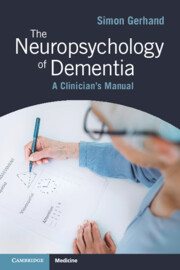Book contents
- The Neuropsychology of Dementia
- The Neuropsychology of Dementia
- Copyright page
- Contents
- Preface
- Acknowledgements
- Section 1 Essential Background Knowledge
- Section 2 Diagnosing Different Types of Dementia
- Chapter 5 Alzheimer’s Disease
- Chapter 6 Vascular Dementia
- Chapter 7 Lewy Body Dementia, Parkinson’s Disease and Parkinson’s Dementia, and Parkinson’s Plus
- Chapter 8 Frontotemporal Dementia
- Chapter 9 Alcohol-Related Brain Damage
- Section 3 Intervention
- Section 4 Recent Developments/Contemporary Issues
- Index
- References
Chapter 7 - Lewy Body Dementia, Parkinson’s Disease and Parkinson’s Dementia, and Parkinson’s Plus
from Section 2 - Diagnosing Different Types of Dementia
Published online by Cambridge University Press: 25 October 2024
- The Neuropsychology of Dementia
- The Neuropsychology of Dementia
- Copyright page
- Contents
- Preface
- Acknowledgements
- Section 1 Essential Background Knowledge
- Section 2 Diagnosing Different Types of Dementia
- Chapter 5 Alzheimer’s Disease
- Chapter 6 Vascular Dementia
- Chapter 7 Lewy Body Dementia, Parkinson’s Disease and Parkinson’s Dementia, and Parkinson’s Plus
- Chapter 8 Frontotemporal Dementia
- Chapter 9 Alcohol-Related Brain Damage
- Section 3 Intervention
- Section 4 Recent Developments/Contemporary Issues
- Index
- References
Summary
This chapter reviews Parkinson’s disease dementia, Lewy body dementia and Parkinson’s plus disorders such as multiple systems atrophy, progressive supranuclear palsy, and cortico-basal degeneration. Incidence and prevalence figures are reviewed, along with the pathological mechanisms underlying these disorders. The difference between Parkinsons’s dementia and Lewy body dementia is considered, along with a review of the diagnostic criteria for each (including Parkinson’s disease mild cognitive impairment). Neuropsychological profiles are considered, although other differences in presentation of these disorders may be more important for diagnosis. Although rare, and more likely to present to neurology services, the diagnostic criteria for Parkinson’s plus disorders are also considered.
Keywords
- Type
- Chapter
- Information
- The Neuropsychology of DementiaA Clinician's Manual, pp. 86 - 104Publisher: Cambridge University PressPrint publication year: 2024

